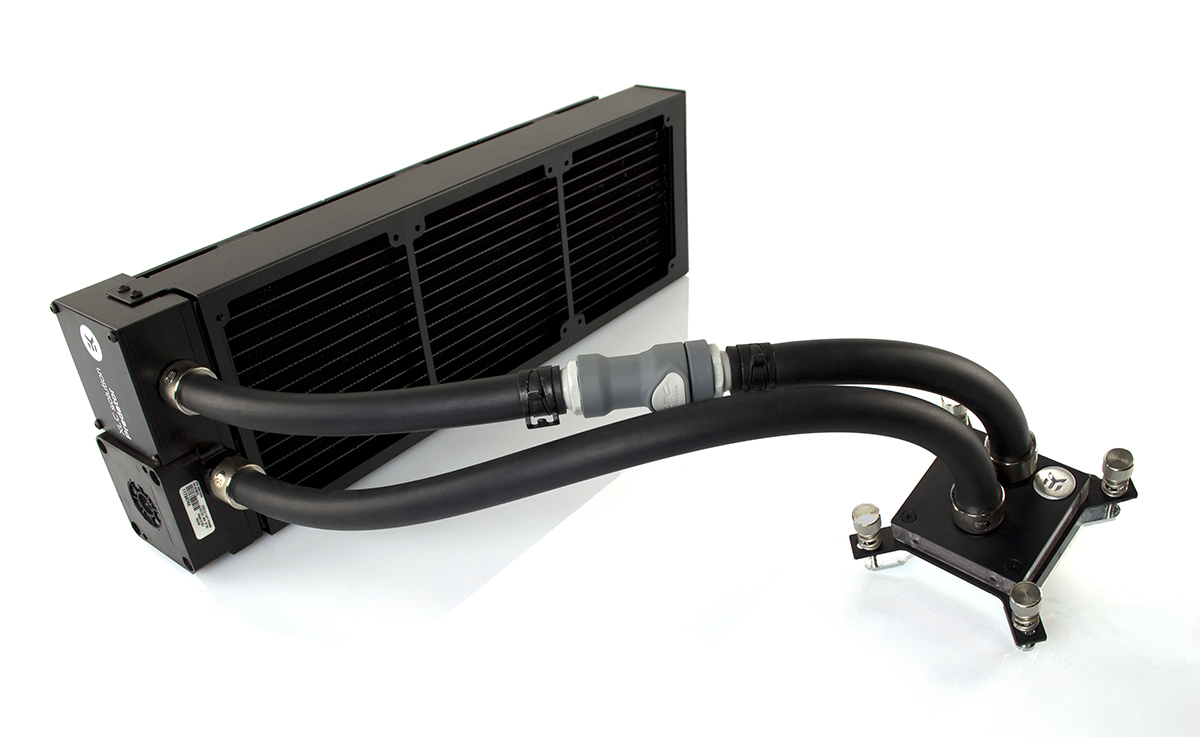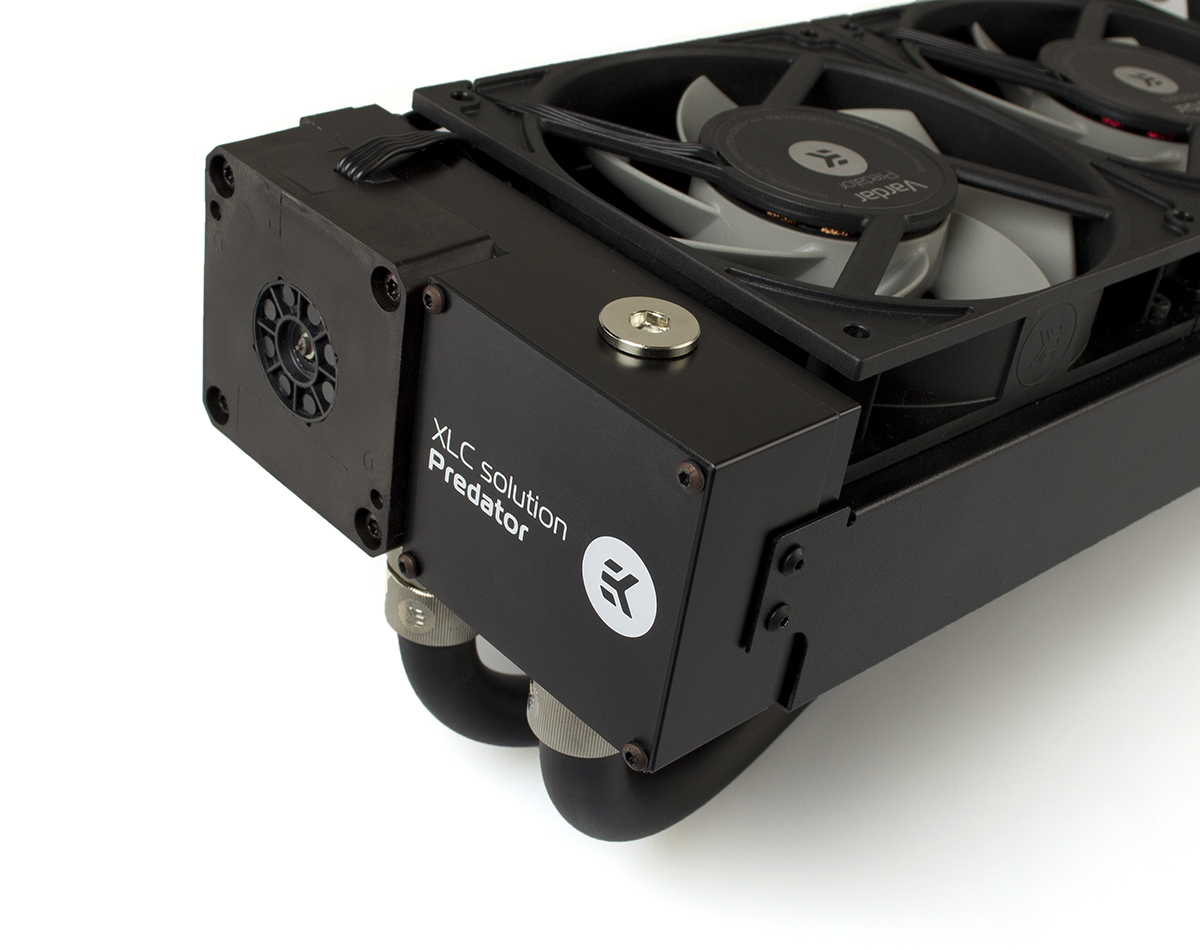How Will EK's Predator Series Coolers Be Expandable And Drip Free?
EK has said that you'll be able to expand its Predator cooler with a GPU block, without messing with any fluid, but how would that work?
While visiting EK in Slovenia, I had a chat with the company's chief of R&D, Niko Tivadar. Among a handful of other topics, one subject that came up was how users would go about expanding the 360 mm Predator liquid cooler.
EK built two EK-XLC Predator liquid coolers – one with a 240 mm radiator, and another with a 360 mm radiator. The latter comes with a quick-disconnect coupling that allows you to expand the loop later on, but many of you have expressed that you're not quite sure how that would work – how would you add a GPU block to a pre-filled loop?
The answer to that question is actually very simple: The GPU block would come pre-filled so that you don't need to mess with any fluids. But that raises another question: How can a GPU block be pre-filled?
What Is Predator Enabled?
EK already announced that on November 5 it will be launching the GPU blocks for the Predator series. Unlike the Predator AIOs, which will be available on shelves at retailers, the pre-filled Predator GPU blocks will be built on-demand. When you browse to the GPU block you want, you'll be able to tick a box labeled "Predator Enabled" in order to pre-fill it.
When you order a Predator Enabled GPU block, EK will take the standalone GPU block, attach its black tubing to it, mount a drip-free medical-grade CPC quick-disconnect coupling, hook it up to a loop to fill it, and ship it to you.
Installation Of A Predator-Enabled Block
When you receive the block, installation should be very simple – you'll mount the GPU block to your graphics card by following the instructions, uncouple the quick-disconnect coupling of the EK-XLC Predator 360, connect the GPU block in the middle of the loop, and that's it.
Of course, it must be noted that while this system makes it very easy to install one extra GPU block, adding a second GPU block to the loop won't really be possible. That's not because the radiator would lack the cooling power, but rather because, due to the placement of the quick-disconnect couplings, it likely won't be possible to route the tubing in a way that fits.
Get Tom's Hardware's best news and in-depth reviews, straight to your inbox.
Naturally, if you ever decide to install a second graphics card, and you've already expanded the Predator loop with one graphics card, you'll always be able to install a non-Predator-enabled GPU block on the second GPU, drain the loop, remove one or more of the quick-disconnect couplings, tube it up, and re-fill the loop. All the parts of the Predator series can be used in conjunction with a normal custom loop, but that will require draining the loop.
What Will it Cost?
The prices of GPU blocks vary from graphics card to graphics card, and also per variant. You'll be able to pick any variant of a block you want, with both a plain copper- or nickel-plated base and a black Acetal or clear Acrylic top.
Predator Enabling a GPU block will cost about $30, which is a great value if you consider that they come on a built-to-order basis.
______________________________________________________________________
Niels Broekhuijsen has been with Tom's Hardware since 2012, and works as a Contributing Editor on the news team. He covers mostly hardware, components, and anything else that strikes his fancy. Outside of work, he likes to travel, cook, and fix things that are broken.
You can follow him at @NBroekhuijsen. Follow us @tomshardware, on Facebook and on Google+.
Niels Broekhuijsen is a Contributing Writer for Tom's Hardware US. He reviews cases, water cooling and pc builds.
-
getochkn I like it. I have a Seidon 240 for my CPU and a H50 for my GPU and would like a loop for both instead with easy to use ability.Reply -
uglyduckling81 The big hurdle is still the stupid price for a GPU block. $100+is crazy. I would rather put that money toward a more powerful GPU option and end up with better performace.Reply
If a GPU water block was $50 at most I would consider it. Otherwise I can not justify the expense and will continue to sit unwatercooled. -
JackNaylorPE I see the attraction for persons who've never tried water cooling but I still so no way to bleed the loop .... even pre-filled coolants outgas and snapping the QDs together has gotta introduce some air.Reply
So while I think it will be popular with novices, the price needs to come down since ya can do a custom loop kit for about the same price.
-
Gam3r01 I think it will be popular for those who use it as an AIO at first, but later turn it into a custom loop. IE remove the QD ports and redo the tubing.Reply -
JackNaylorPE I think EK did a wise thing and made a 360 since just about any mid size case will fit one.... I think Swiftech dropped the ball here. Given the pricing, my first thought was that Swiftech will maintain the lead in the dual rad space and EK will woo peeps away from Swiftech where peeps wanna "go bigger" and get the 360.Reply
OTOH, some peeps will realize that the 2 x 140 Swiftceh unit at $150 provided 90% of the cooling capacity of the $230 EK 360. For my own and user builds, I still prefer custom loops where budget allows and it's hard to recommend the EK over a custom loop kit given the lack of price difference. One thing that both fall short on is Swiftech doesn't do a triple and EK doesn't do a 140mm wide model. And given current case preferences that all offer 140mm wide rads, and the superiority lower price in WC builds w/ 140mm fans I think this will set the tone as being favored by enthusiasts. A 420 is equal / better than a 480 while costing less and uses 2 less fans in push pull.
Just like the 980 Ti doesn't have a lot of market share, but it is the undisputed "king of the hill", that leads to a lot of sales of lower cost sales in the product line. A 420 model would likely "win the title" and therefore drive sales of the lower cost / size models accordingly. Also, I oft recommend against a 240 / 280 on open loop AIOs cause when ya add those GFX card Water blocks....you're wasting a lot of radiator space up on top oft forcing you to "miss that extra 120/140 that "cuda been there" w/ sacrificing any case space. -
Gam3r01 Honestly I hate reccomending AIOs in the first place. Go big air, and if you have money for more than that, save up the extra to go custom.Reply
My own AIO is probably the biggest regret I have in my own rig. -
stoned_ritual ReplyHonestly I hate reccomending AIOs in the first place. Go big air, and if you have money for more than that, save up the extra to go custom.
My own AIO is probably the biggest regret I have in my own rig.
I got hit by the AIO hype virus a couple years ago with an Antec Kuhler, and I'll be damned if it didn't drop my temps like a son of a gun. Then I thought "I should upgrade" so I got a corsair h80i, and my temps INCREASED by about 20 degrees, AND I had to change those jet turbine fans that came with it. After doing a whole lot of research, I found out that the corsair h80i uses a really bad pump, and was accompanied by really bad firmware. Further research showed me that AIO coolers are rarely, if ever, more efficient than a good air cooler and at a considerably higher price. This is from the small diameter tubing, low volume of coolant (i drained about a shotglass full of PG from the h80i), low volume pumps, and the radiators themselves have less surface area than a good air cooler. More surface = more dissipation. -
thundervore This is the start of the downfall of the Asetek AIO, FINALLY!!!Reply
Now if the have predator enabled Monoblocks I will be all in. But please, kindly work on the pricing!




